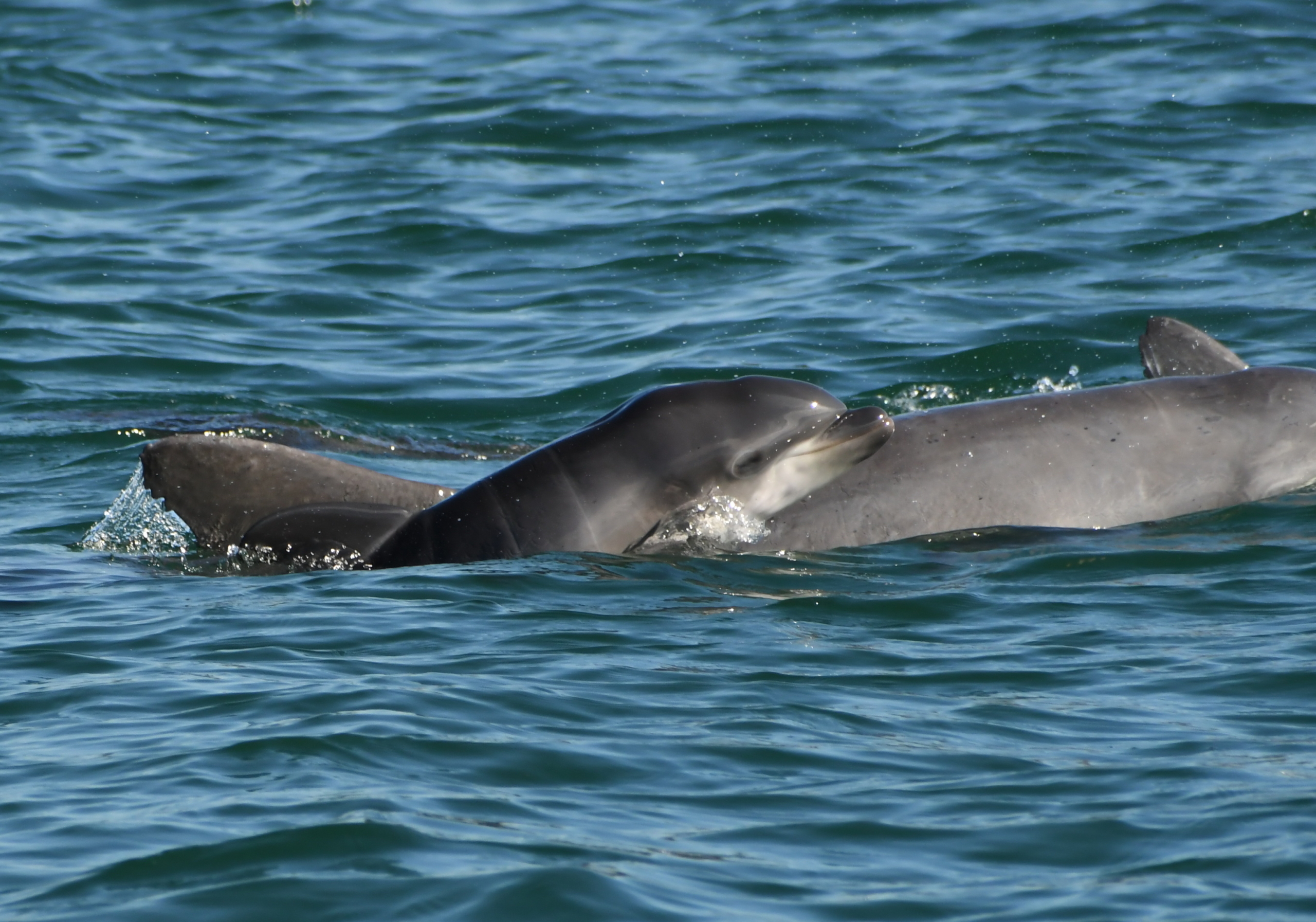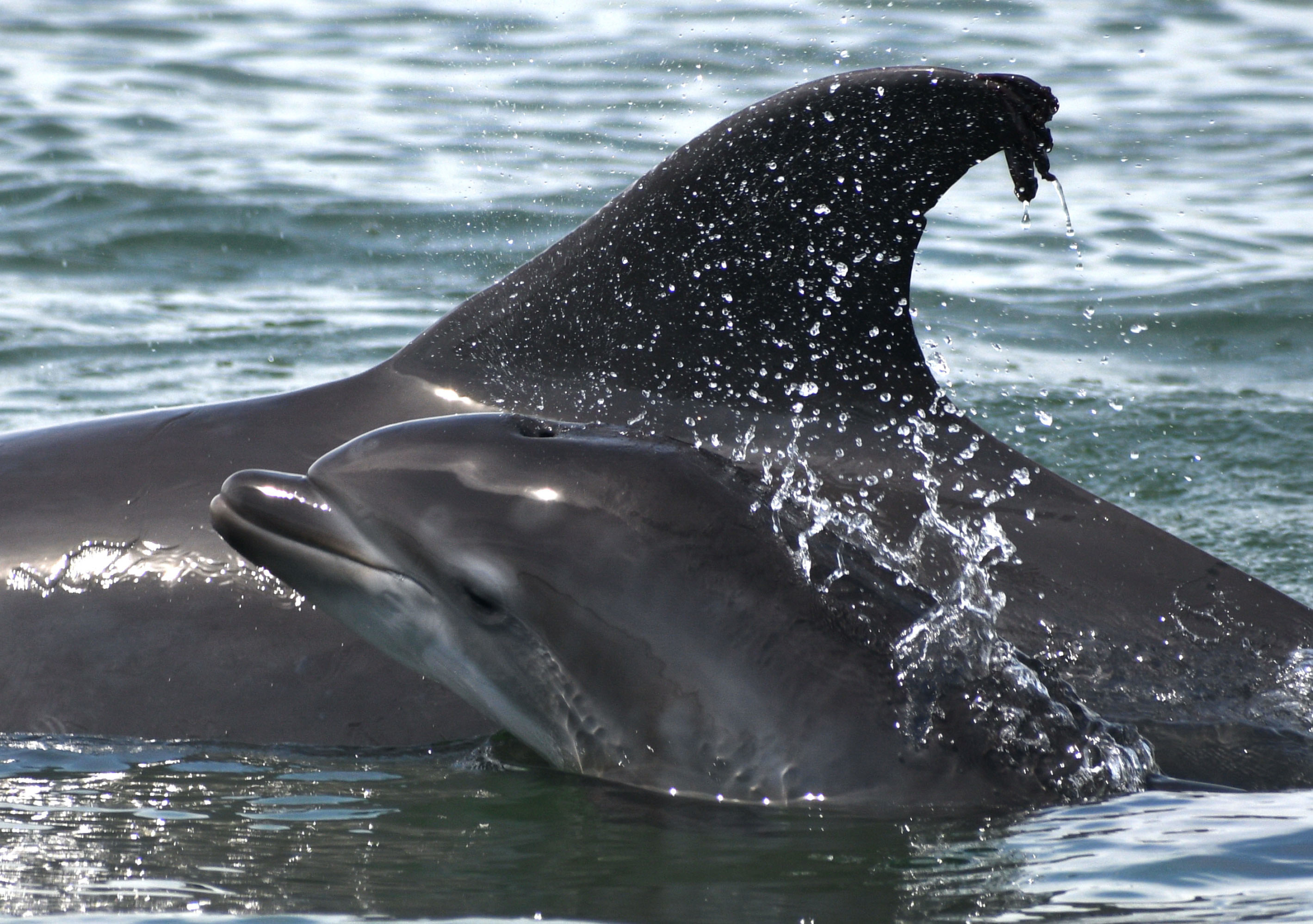The Chicago Zoological Society’s Sarasota Dolphin Research Program has documented 22 dolphin births in 2021 to the long-term resident bottlenose dolphin community of Sarasota Bay, Florida, exceeding the record of 21 set in 2017. The newest calf was first observed with its mother, known as Squarenotch, on Dec. 2.
Forty-four-year-old Squarenotch has been observed since 1980 and this is her sixth documented calf. “It’s great to see the continuing productivity of the Bay’s dolphins, and really interesting that it was one of our older females that put us over the top,” said Dr. Randy Wells, Vice President of Marine Mammal Conservation for the Chicago Zoological Society (CZS) and Director of the Sarasota Dolphin Research Program (SDRP), which is based at Mote Marine Laboratory.

Squarenotch was one of the 466 dolphins that Wells documented as part of his University of California, Santa Cruz Ph.D. dissertation “Structural Aspects of Dolphin Societies,” which he completed in 1986. As part of that work, Wells examined the population structure and social units of dolphins in Southwest Florida. His studies further expanded knowledge of the Sarasota Bay dolphin community, building on research that began in 1970 with the seminal finding that the Bay’s dolphins were long-term residents across decades and generations. Today, the Bay’s dolphins are the focus of the world’s longest-running study of a wild dolphin population.
Finding that identifiable individual dolphins could be studied for extended periods of time in their own natural habitat has allowed researchers to gain insight into dolphin biology and physiology and delve deeply into the dolphins’ day-to-day lives of complex social interactions as a society. It has also improved understanding about their needs in the face of increased human activity in coastal waters.
“It’s exciting to document new calves each year as one measure of the health of the Bay’s dolphin population and the health of the Bay itself,” Wells said. “But the long-term nature of our research allows us to drill deeper and consider the question of why we had a record number of births. It appears that the red tide that reached Sarasota Bay in 2018 may have played a role.”
The red tide that entered Sarasota Bay in the summer of 2018 was unusually strong and lasted through the winter of 2018-2019, killing marine life and causing millions of dollars in losses to coastal economies. During and following the bloom, SDRP researchers:
- Caught fewer than half the average number of stingrays than expected during prey fish surveys conducted during the summers of 2019 and 2020. SDRP has been conducting catch-and-release purse seine fish surveys in shallow seagrass meadows since 2004. These surveys provide information on the relative abundance of dolphin prey and other fish in Sarasota Bay.
- Used photographic identification surveys to determine that Sarasota Bay dolphins were bitten by sharks in record numbers in 2019 and 2020.
- Documented that 45 percent of the females that gave birth to calves in 2021 had lost dependent calves during or since the red tide. On average, 31 percent of Sarasota calves do not survive more than two years, so there were increased losses of calves during the red tide period.
“Adding these facts together allows us to make some tentative inferences,” Wells said. “We know that stingrays are a primary prey item for sharks. When a preferred prey is unavailable, they’ll look to alternatives.
“The loss of typical shark prey may have led to the increased interactions we documented between sharks and dolphins as alternative prey, which allows us to infer that increased shark predation accounts for at least some of the losses of dependent calves during that period. When we document decreased ray catches, we tend to see increased disappearances of young dolphin calves.”
Since Sarasota dolphins typically rear their young for about four years, the loss of dependent calves before that age during and following the red tide (2018-2019) meant that more females were available to reproduce in 2020, contributing to the increase in the number of births this year, Wells said.
“The record number of births is a wonderful story in itself, but thanks to our long-term data, we’re able to develop hypotheses about some of the factors that may have led to this result, which should lead to a better understanding of what can happen to an animal population when an environmental anomaly occurs,” Wells said.
Primary funding for the photographic identification and prey fish surveys was provided by the Charles & Margery Barancik Foundation, which has a long-term commitment to supporting Sarasota Bay dolphin research.
“We appreciate the work of Dr. Wells and his team who track our dolphins, water-based ecological sentinels, that help us identify whether our local environment is healthy and sustainable,” said Teri A Hansen, President|CEO of Barancik Foundation.
The Calves of 2021
FB79 and calf C79A
We observed FB79, also known as Vespa, with C79A on April 21, 2021. C79A was the first calf we documented in 2021. This is Vespa’s 11 documented calf. Her previous calf disappeared in 2019. Learn more about Vespa’s life here.
F131 and calf 1319
F131, also known as Claire, is pictured here with her ninth calf, 1319, on May 5, 2021. Her previous calf, 1318, was last seen on Sept. 23, 2021.
1316 and her calf 1361
We observed 1316 with her first calf, 1361, on May 5, 2021.
F209 and calf 2094
We documented the fourth calf of F209 on April 26, 2021. Her last calf, 2093, was born in 2019 and disappeared that same year.
HWK3 and calf HK33
We documented HWK3’s calf HK33 on May 6, 2021. Her previous calf, HK32, was born and disappeared in 2019.
F285 and calf 2851
F285 gave birth to her first calf this year. Meet 2851, who we first observed on May 10!
F113 and calf 1138
F113 — also known as Lizzie — gave birth to her eighth calf, 1138, this year. We first observed the calf on May 12. Her last calf, 1137, was born in 2018 and disappeared in 2020. In 2013, we rescued Lizzie from entanglement. Read more here.
F135 and calf 1354
We documented F135, also known as Tricia, with her fourth calf, 1354, on June 1. F135 gave birth to her previous calf, 1353, in 2018. That calf was last seen on Sept. 7, 2021.
F235 and calf 2351
We documented F235 with her first calf, 2351, on June 1.
1092 and calf SKE2
SKE2 is the second calf of mom 1092. The calf was first observed on June 1. 1092’s previous calf, SKE1, was born in 2017 and was most recently observed on Oct. 4, 2021.
F133 and calf 1334
F133, also known as Bobbit, was observed with her fourth calf on June 4, 2021. Her previous calf, 1333, was born in 2019 and disappeared that same year.
F243 and calf 2432
F243’s second calf, 2432, was first observed on June 4, 2021. Her previous calf was born in 2019 and disappeared that same year.
F247 and calf 2471
We observed F247’s first calf on July 9, 2021.
F233 and calf 2332
We observed F233’s second calf on July 11, 2021. Her previous calf was born in 2019 and disappeared that same year.
F151 and calf 1513
Calf 1513 (pictured in the back with her rostrum above water) was observed for the first time on July 12, 2021. Mom, also known as Holly, had her previous calf, F267 in 2015. You can learn more about F267, also known as Joy, here.
F159 and calf 1596
F159, also known as Aya, was observed with her sixth recent calf, 1596, on Aug. 2. Her previous calf was born in 2018 and has not been seen since 2020. Aya’s lineage is a sixth-generation maternal lineage that we know from our population studies. Read more about her life here.
F227 and calf 2273
F227, also known as Patch, was observed with her third calf on Aug. 20, 2021. Her previous calf was born in 2017 and was last seen in 2019.
F149 and calf 1498
F149’s eighth calf was first observed on Aug. 23, 2021. Her last calf, born in 2017, disappeared that same year.
F167 and calf 1676
F167 was observed with her sixth calf on Aug. 23, 2021. Her previous calf, 1675, was born in 2017 and was last observed on July 9, 2021.
F125 and calf 1257
F125, known as Little Orphan’s Annie, was observed with her seventh calf, 1257, on Sept. 13, 2021. Her previous calf was born in 2020 and died after becoming entangled in fishing gear that same year. Learn more about Little Orphan’s Annie here.
F215 and calf 2154
F215 was observed with her fourth calf on Dec. 1, 2021. Her previous calf, 2153, was born in 2016 and last observed on Aug. 11, 2021.
FB87 and calf C876
FB87, also known as Squarenotch, was born in 1977 and has been observed since 1980. Her sixth documented calf was first seen on Dec. 2, 2021. Squarenotch is one of the 466 dolphins identified by the SDRP’s Director, Dr. Randy Wells, as he conducted his Ph.D. research “Structural Aspects of Dolphin Societies.”





